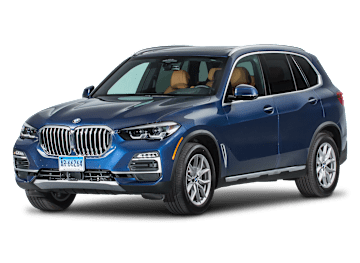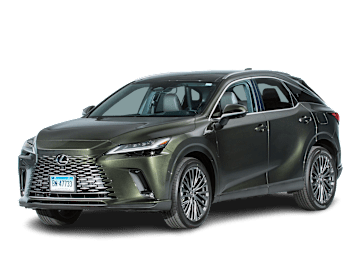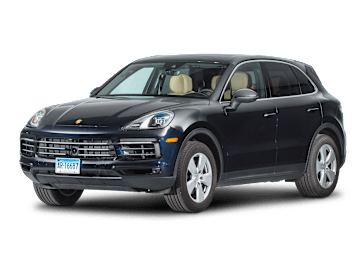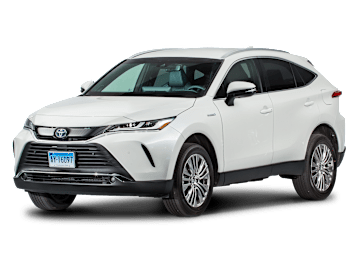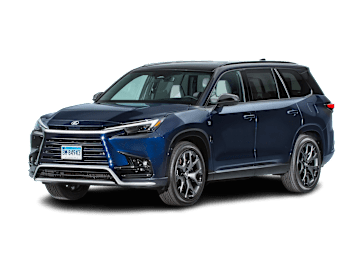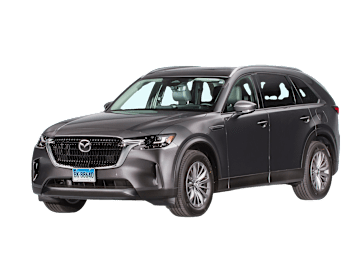Most Reliable New Midsized SUVs You Can Buy Right Now

Consumer Reports’ surveys show which of these popular two- and three-row SUVs are smart buys for the long haul
Lexus RX
By Jon Linkov
Midsized SUVs combine roomy interiors and plenty of cargo space in a package that’s still relatively easy to drive and park. Some models come with all-wheel drive for rough weather, and a few offer a compact third row of seating that adds flexibility.
But some of the most popular midsized SUVs are also among the least reliable, according to our exclusive survey data, which includes information on more than 330,000 vehicles. To keep you from wasting your time and money on repairs down the road, Consumer Reports compiled this list of the most reliable new midsized SUVs based on those insights. That way, you can make a smarter purchase decision.
The two- and three-row SUVs below have above-average and well-above-average reliability ratings. On top of that, each comes standard with key active safety equipment, including automatic emergency braking (AEB) with pedestrian detection, highway-speed AEB, blind spot warning (BSW), and rear cross traffic warning (RCTW), unless otherwise noted. These SUVs also performed well in government and insurance-industry crash tests if they were tested.
We’ve listed them in order of their Overall Score, which is a combination of all those factors. Though we tested more expensive all-wheel-drive versions of some of these, we also recommend the less expensive front-wheel-drive versions, if they’re sold that way. Some of these models have our Green Choice designation, which highlights vehicles with the cleanest emissions.
If you’re a CR member, the list below is already available to you. But if you haven’t signed up yet, click below and become a member to access this list and all our exclusive ratings and reviews for each car we buy and test. Joining also gives you full access to exclusive ratings for the other products our experts evaluate in several categories, including electronics and home appliances.
Two-Row SUVs
The X5 is one of the best vehicles we’ve ever tested, and it’s among the most reliable vehicles in our survey. The standard 3.0-liter turbo six-cylinder engine now makes 375 hp. The version we tested was quick and smooth, yet we got a decent 23 mpg overall. The ride is comfortable and impressively steady and composed. The luxurious cabin is whisper-quiet, and the seats are all-day comfortable. Handling isn’t sporty but is very competent.
The plug-in hybrid electric version of Lexus’ popular midsized luxury SUV is both quicker and quieter than the RX hybrid, and it also has a decent EPA-estimated 37 miles of electric driving. Once the battery is drained it delivers the same 34 mpg as the regular hybrid. It takes about 3 hours to charge the 18.1-kWh battery on a 240-volt connection. Power is plentiful, but there’s an uncouth growl when the system transitions from quiet electric operation to the four-cylinder gas engine. In other respects, the PHEV is similar to the rest of the RX line, with a comfortable ride, sound handling, and a quiet cabin. The front seats are comfortable, and the rear seat is roomy.
The recently redesigned Lexus RX 350h hybrid version is sparing with fuel, at 34 mpg overall. It has a comfortable ride, especially when fitted with the standard 19-inch tires vs. the optional 21-inch. Handling is sound and secure but not sporty. The well-finished cabin has lots of padded surfaces and exposed stitching. The front seats are comfortable, and the rear seat is generously sized. The infotainment touchscreen isn’t the most intuitive, and both the electronic door latches and the gear-selector lever take familiarity.
The CX-70 is a five-passenger version of the CX-90 and uses the same rear-wheel-drive-based platform with standard all-wheel drive. The standard 280-hp, 3.3-liter turbocharged inline-six incorporates a mild-hybrid setup. A more potent 340-hp Turbo S and a plug-in hybrid with an EPA-estimated EV range of 26 miles are also available. The eight-speed automatic transmission is smooth and responsive. We got 24 mpg overall in our CX-90 powered by the standard engine. Athletic handling, confident steering, and reassuring brake pedal feel make the CX-70 enjoyable to drive. The ride is firm and controlled and a bit too stiff with the 21-inch tires.
A freshening for 2024 brings interior updates inspired by the Taycan EV, including a curved display that houses Porsche’s latest infotainment system. Few SUVs can match the Cayenne when it comes to handling agility. But the ride has an underlying firmness, and some jolts come through. With the base 3.0-liter V6 turbo, acceleration is robust once on the fly, but the Cayenne exhibits some initial hesitation off the line and the rough engine stop/start feature undermines smoothness. The interior fit and finish is top-notch, however. The seats are very comfortable and supportive.
The Venza is a pleasant enough vehicle, but other than the excellent 37 mpg overall, it doesn’t stand out in the midsized segment. The 2.5-liter four-cylinder engine and electric motor drive all four wheels. We found that the Venza rides comfortably and handles soundly but that tire and engine noise can be pronounced. The controls are very distracting to use and take time to master. One big feather in the Venza’s cap is its above-average reliability.
The Edge is a roomy and capable SUV. Most versions come with the standard 2.0-liter turbo four-cylinder and eight-speed automatic transmission, which returned 22 mpg overall in our tests. This combination provides smooth, quiet acceleration. The spacious interior provides comfortable quarters, and cargo room is generous. However, the driving position is uneven because the left footrest sits too close to the driver. The Edge can rival some luxury SUVs with its quiet cabin, steady ride, and agile handling. 2024 is the final model year for the Edge.
The nonhybrid RX is powered by a 2.4-liter turbocharged four-cylinder mated to an eight-speed automatic. The new engine is powerful and gets a good 24 mpg overall, but it lacks the silky smoothness of the old V6. The RX’s ride is comfortable, especially when fitted with the standard 19-inch wheels and tires. Handling is sound and secure but not sporty. The cabin is well finished, the front seats are comfortable, and the rear seat is generously sized.
Three-Row SUVs
Lexus’s all-new three-row TX is based on the Toyota Grand Highlander and comes with two main powertrains: a 275-hp turbo four-cylinder in the TX350, and a smooth and powerful 366-hp turbo four-cylinder hybrid in the 500h F Sport. We found that the TX500h possesses some handling agility, and even though the ride skews firm, it’s steady and controlled. The TX350 is more mundane through corners but is still a highly functional and luxurious vehicle. The TX has spacious accommodations in all three rows and tremendous cargo-toting abilities when the third row is folded.
Like the regular Highlander, the Hybrid version has a comfortable ride and secure handling. But it’s all about fuel economy for the hybrid. In our tests, we got an excellent 35 mpg overall with the 243-hp, 2.5-liter four-cylinder and electric powertrain, although when more power is needed the engine kicks in with a roar. Otherwise, the Hybrid has the same interior, roomy cabin, and easy-to-use controls as the regular Highlander.
The Palisade three-row midsized SUV can seat seven or eight people, depending on whether the second row is a bench or two separate captain’s chairs. It shares its platform and many components with the Kia Telluride, including its smooth 291-hp, 3.8-liter V6 that’s paired with an eight-speed automatic. The roomy cabin is very quiet. The Palisade rides comfortably, but handling is not particularly nimble. The interior is filled with thoughtful details and benefits from simple controls, except for the unintuitive push-button gear selector and the faraway touchscreen infotainment system.
The three-row CX-90 uses a new rear-wheel-drive-based platform but has AWD standard. Lower trims get a 280-hp, 3.3-liter turbocharged inline-six, with upper trims using a 340-hp version of the engine. Both are paired with a smooth-shifting eight-speed automatic. We got 24 mpg overall with the 280-hp version. The plug-in hybrid employs a 2.5-liter four-cylinder, a 17.8 kWh battery, and an electric drive that gives it an EPA-estimated 25 miles of electric driving range. After that, it will transition to regular hybrid operation. In our fuel economy tests it returned 23 mpg. The CX-90’s handling is taut and agile, and the ride is firm and composed, but the 21-inch tires on higher trims make the ride too stiff. The front seats are supportive and the second row is roomy and comfortable, but the third row is best suited for kids. Some of the controls, such as the gear selector, are quirky.
The three-row Grand Highlander brings a roomier cabin and more cargo room to the Highlander platform. Three powertrains are available: a raspy-sounding 2.4-liter, turbo four-cylinder that returned 22 mpg overall in our tests, a thrifty 2.5-liter hybrid, and a powerful 2.4-liter turbo hybrid. Power from the standard engine is adequate and the ride is comfortable, but handling is short on agility. We found the wide and accommodating front seats comfortable, the second-row bench seat roomy, and the third row much more hospitable to adults than the regular Highlander. Cargo capacity has also been expanded. Controls are simple, and the standard 12.3-inch touchscreen infotainment system is mostly user-friendly.
Consumer Reports is an independent, nonprofit organization that works side by side with consumers to create a fairer, safer, and healthier world. CR does not endorse products or services, and does not accept advertising. Copyright © 2024, Consumer Reports, Inc.
Source link


